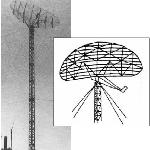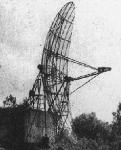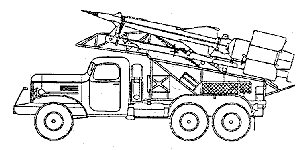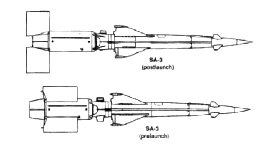




 The S-125 SA-3 GOA medium altitude surface-to-air missile system uses a two-stage, solid-fuel missile built by the Isayev OKB. The S-125 missile includes a large 2.6 second burn-time solid propellant booster with rectangular fins that rotate through 90� at launch. The smaller main stage has an 18.7 second burn-time solid propellant sustainer motor, and has four aft fixed fins and four forward movable control. Following booster jettison the missile is tracked by the system's radar with guidance signals sent to an antenna on the rear fins.
The S-125 SA-3 GOA medium altitude surface-to-air missile system uses a two-stage, solid-fuel missile built by the Isayev OKB. The S-125 missile includes a large 2.6 second burn-time solid propellant booster with rectangular fins that rotate through 90� at launch. The smaller main stage has an 18.7 second burn-time solid propellant sustainer motor, and has four aft fixed fins and four forward movable control. Following booster jettison the missile is tracked by the system's radar with guidance signals sent to an antenna on the rear fins.
US intelligence imagery at Kapustin Yar in late 1959 revealed two probable R&D sites, each of which consisted of four launch pads. A possible launcher on one of the pads held two missile-like objects about 20 feet long. US intelligence subsequntly identified more than 35 sites of this type in the USSR between late 1961 and 1964, usually near SA-1 or SA-2 sites. The initial SA-3A GOA Mod 0, deployed in 1961, includes command guidance throughout the missile's flight. The subsequent SA-3B GOA Mod 1, first deployed in 1964, incorporated an improved guidance system. The missile's ability to dive allows it to be used against surface targets and naval vessels.
Long-range surveillance and target acquisition is handled by the van-mounted P-15 FLAT FACE) radar. The P-15 radar has been replaced in many S-125 units by the P-15M SQUAT EYE radar, which has the antenna mounted on a 20-30 m mast for improved low altitude coverage. The accompanying PRV-11 SIDE NET E-band height-finding radar has a range of 180 km covering targets at altitudes of up to 32000 meters.
Target data generated by these tracking radars is passed to the battalion's LOW BLOW trailer-mounted fire control radar. With a maximum acquisition range of 110 km, the tracking
range of this I-band system is between 40-85 km, depending on target size and altitude. The system can simultaneously track six target aircraft and guide one or two missiles. Improved LOW BLOW radars include TV cameras with a range of 25 km to provide the fire control team with the data needed to perform a command guidance intercept in a heavy ECM environment. If the missile fails to intercept it would be commanded to either change trajectory or self-destruct.
The S-125 is fired from trainable launchers which are normally fixed, but can be relocated. The crew loads the missiles with the aid of a conveyor onto the ground-mounted, trainable launcher for firing, with both twin and quadruple launchers in use. A pair of missiles are carried in tandem on a modified truck or tracked vehicle. The S-125 is normally transported from battalion storage areas on modified ZIL-131 (6 x 6) or ZIL-157 (6 x 6) trucks and loaded onto the launchers. Approximately one minute is required to load the missiles onto the launch rails, but nearly an hour is required between missile launches due to missile preparation, truck transit and other reloading procedures.
| SQUAT EYE | P-15M(2) |
| Function |
|
| Range | 128 km |
Frequency | C-band |
Associated weapon system | SA-3/5 |
Recognition 
| Power 380kw |
| SIDE NET | PRV-11 |
| Function | Height |
| Range | 28 km |
Frequency | E-band |
Associated weapon system | SA-2/3/5 |
Recognition 
|
Specifications |
|
|
Missile Characteristics: |
|
|
DOI |
1961 |
|
Status |
Standard |
|
Length (m) |
6.70 |
|
Diameter (m) |
.60 |
|
Weight at launch (kg) |
400 |
|
Propulsion system |
|
|
Booster |
Solid |
|
Sustainer |
Solid |
|
Launch rails/tubes |
2 or 4 rails, ground mounted (not mobile) |
|
Guidance |
Command, (poss. IR terminal homing) |
|
Warhead (type) |
HE |
|
Kill Radius |
12.5 m |
|
Performance: |
|
|
Max. velocity (Mach) |
3+ |
|
Max. altitude (m) |
25,000 |
|
Min altitude (m) |
100 |
|
Operational range (km) |
25 |
|
Minimum range (km) |
6 |
|
Reload time (min) |
50 |
|
Associated radars |
FLAT FACE, LOW BLOW, SQUAT EYE |


